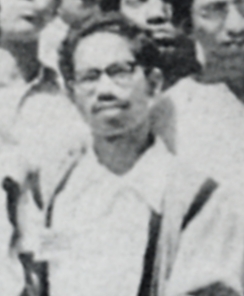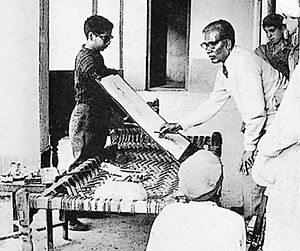Murtaja Baseer facts for kids
Quick facts for kids
Murtaja Baseer
|
|
|---|---|
| মুর্তজা বশীর | |

Baseer in 1954
|
|
| Born | 17 August 1932 |
| Died | 15 August 2020 (aged 87) Dhaka, Bangladesh
|
| Resting place | Banani Graveyard |
| Nationality | Bangladeshi |
| Alma mater |
|
| Occupation | Painter |
| Parent(s) |
|
| Relatives | Muhammad Takiullah (brother) |
| Awards | full list |
Murtaja Baseer (born August 17, 1932 – died August 15, 2020) was a famous Bangladeshi artist. He was best known for his paintings that mixed real-life scenes with abstract, dream-like ideas. Besides being a painter, he was also a poet, writer, researcher, and even studied old coins (a numismatist). He also worked on films.
Baseer received two of Bangladesh's highest honors. He got the Ekushey Padak in 1980. Later, in 2019, he was awarded the Swadhinata Padak, also known as the Independence Day Award.
Contents
Early Life and Learning
Murtaja Baseer was born to Muhammad Shahidullah and Marguba Khatun. His father, Shahidullah, was a very respected scholar and expert in languages.
Baseer started studying art at Dacca Art College in 1949. This college is now called the Faculty of Fine Arts, University of Dhaka. After finishing there in 1954, he went to Italy. He studied at the Academy of Fine Arts of Florence from 1956 to 1958. Later, he also studied art techniques like mosaic and etching in Paris, France. He was at the École nationale supérieure des Beaux-Arts (ENSBA) from 1971 to 1973.
His Artistic Journey

When Baseer returned from France in 1973, he joined the University of Chittagong. He started as an assistant professor of fine arts. He taught there until he retired in 1998, as a professor. In the 1950s, he was involved in political groups that wanted social change. He even faced challenges for his beliefs before Bangladesh became independent.
Famous Paintings and Art Style
Murtaja Baseer's painting style changed over time. In his early days, his art looked very realistic. Later, it became more abstract, mixing real elements with imaginative ones. His paintings often showed what he thought about society. He used detailed lines and balanced colors to express his ideas.
He often painted Bangladeshi women. His art showed their unique spirit and strong personalities. Peace was a common theme in his work. For example, his collage "No More War" showed his feelings against the Iraq war. Another collage, "Statue of Liberty," highlighted how war affects women and children who have to leave their homes.
In the 1950s, he was inspired by Indian painters like Paritosh Sen. He also learned from Renaissance painters from the 13th and 14th centuries. These older artists influenced how he used light and perspective.
In 1971, Baseer moved to Paris with his family. He did this because he supported the liberation movement in Bangladesh (then East Pakistan). During this time, he painted his "Epitaph for the Martyrs" series. These paintings had a serious background, inspired by the streets of Paris, to honor those who died.
He also researched traditional art in Bangladesh. In 1987, he received a special grant from the British Council for this work. In 1988, he visited many museums in India. He also explored thousands of villages to study folk art.
Some of his well-known paintings include Somnambular Ballad, The Gypsy, and Man with Accordion. Other famous works are Girl with Flower, Epitaph for the Martyrs, and No More War. One of his watercolor portraits is even displayed at the Louvre museum in Paris, France. His art has been shown in many countries around the world.
Beyond Painting: Author and Filmmaker
Murtaja Baseer was also a talented writer. He wrote several novels, such as Ultramarine (1954) and Kanch-er Pakhir Gaan (1969). He also wrote for older literary magazines like Dilruba and Samakal. His first published poem was called Parbe Na.
He also worked in films. In 1964, he helped create the Bengali film Nadi O Nari (The River and the Women). He wrote the script, designed the sets, and was a main assistant director. He also worked as an art director for the Urdu film Kaise Kahoon in 1965.
In 2004, he published a research book. It was about the history of Bengal based on old coins and inscriptions. He also wrote many articles for the Journal of the Numismatic Society of India.
His Final Years
Murtaja Baseer passed away on August 15, 2020, in Dhaka. He was 87 years old, just two days before his 88th birthday. He died from COVID-19 during the COVID-19 pandemic in Bangladesh. He had been receiving treatment at Evercare Hospital. After his death, he was buried at Banani graveyard, next to his wife, Amina Baseer.
Awards and Recognition
- Prix National, Festival of Paintings, Cagnes-sur Mer, France (1973)
- Academy Award by Bangladesh Shilpakala Academy (1975)
- Best Cover Design, National Book Centre, Dhaka (1976)
- Ekushey Padak (1980)
- Sultan Padak, Narail (2003)
- Star Lifetime Award (2016)
- Independence Day Award (2019)

